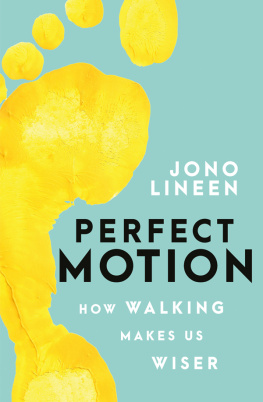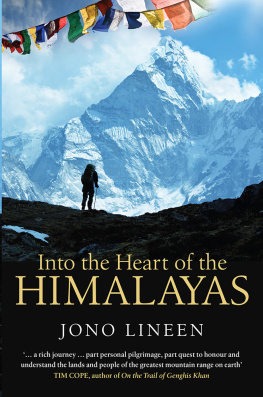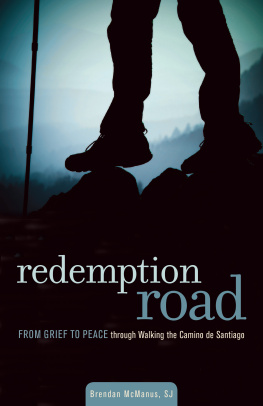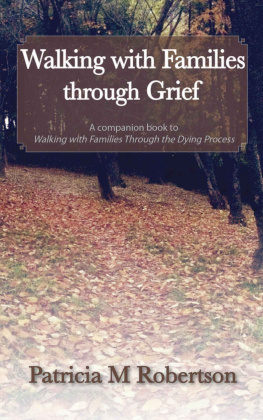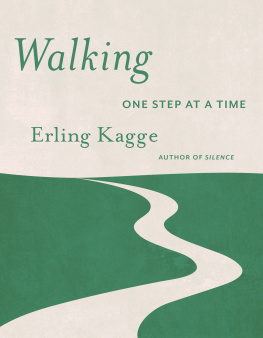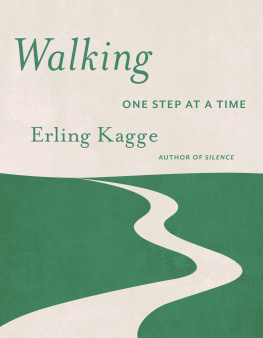About the Book
Since our first ancestor rose up to place one foot in front of another, our desire to walk has produced fundamental changes in our bodies and minds.
In Perfect Motion , Jono Lineen investigates that transformation, and why walking has made us more creative, helped us to learn, constructed our perception of time, strengthened our resilience and provided a way of making sense of our life and death.
After the tragic loss of his younger brother, Lineen experienced walkings regenerative power firsthand. Grief-stricken and adrift, he set off on a 2700-kilometre solo trek across the Himalayas. By the end of the expedition something had changed in him. He was stronger not just physically, but psychologically and emotionally.
What had happened? What had given him this feeling of peace; joy even? Determined to find out, he began researching the science and history of walking and running, and discovered that there were fascinating reasons for his metamorphosis. Weaving together his own remarkable personal stories with evolutionary research, psychology, neuroscience, anatomy and philosophy, Lineen reveals the powerful effect that even the shortest strolls can have on us. Walking is what were made to do; it is our perfect motion.
Introduction
I walk, therefore I am
I rise. I rise and take my place between the earth and sky. Standing tall on two legs, chest high and chin up, I breathe and let the world in. I am a pillar, a receptacle and a witness to the world.
My lungs relax and release, mountain air whistling over chapped lips. As my balance shifts, I fall forward towards a stony track, and for the blink of an eye my foot swings and Im caught between two hemispheres of motion, left and right, floating in equilibrium. Here is where the constancy lies, always present, but hidden the still point between kinesis and stasis. Then the nudge of evolution transfers my gravity and I roll into another stride. My footsteps quicken as I head towards the snow-covered pass, but I have no fear of falling because infinite repetition has instilled in me the confidence of ages, and I move easily into the flow of a steady walk.
This is the magic of beginnings. Here I am at the start of a 2700-kilometre trek through the Western Himalayas. My steps continue, one, two, one, two, tension and compression. Theres a subtle rhythm to the married tip-tap of feet and heart, a measured swing as legs and arms undulate through space and time. The movement transforms me from witness to actor, from observer to participant. To move, to activate this charged body, is to take control. To be dynamic and engaged is to create my own reality.
Footstep after footstep, each piece of walkings moving puzzle is laboured and dangerous. One misstep, an overcorrection, and I am on the ground with bruises. But this deft sequence of connected stumbles, a sine wave of human motion, has the grace of peril about it. Back and forth and onwards, the reel and throw of feet, hips, shoulders, head and hands all combine to create our species most fundamental dance: walking.
These elegant steps and every one of them is a masterpiece are a portal into our antiquity; this towering movement is sheer audacity. The thought that our distant ancestors decided it was a good idea to stand on two legs, shift their weight and move forward shimmers with brilliance. There was both madness and genius in that first person rising to their hind legs to snatch a piece of glowing fruit, and then shuffling two paces more to grab another.
The madness lies with the vulnerability that two-footed locomotion exposes us to, not just in the environment but with friends and foes. Other animals stay on four legs and protect their soft underbellies, but genus Homo stood tall and walked upright, face-first into the future, heroic before the challenge. One, then two, three, then entire families recognised the crazy wisdom of rising up, and shed their fear of being unguarded, because great art, great decisions, great ideas always open us up to the worst and best.
To move ahead you must be tested, to walk strong you cant be afraid; you need the confidence of believing you wont tumble and have a sabre-toothed tiger rip the heart from your bared chest. It has taken 5 million years of falling and rising for us to become who we are, but we have persevered, and in that persistence lies the accumulation of ingenuity that is at the core of our progress.
Walking is what we are made to do. Our development into bipedal animals is an event coded so deep within us that although it can be easily ignored, it is impossible to forget. Everything about how we function in this world, from our cognition to the way we breathe, eat, move and procreate, even how we defecate, is built around a two-legged body that has pulled itself up off the ground and spent a hundred thousand generations perfecting how we interact with other humans and this planet.

It was the tragic death of my little brother in a terrible boating accident that eventually led me to embark on that four-month Himalayan traverse. I began the trek uneasily, strangely unaware of just how deeply Gareths passing had affected me, and in that state of unrealised loss I threw myself into the journey. I walked six to ten hours at a stretch, 40 kilometres a day, seven days a week. I walked until my legs ached and my feet blistered.
Day after day, month after month I kept walking, and by the time I reached the Mahakali River, the border between India and Nepal, and the end of the trek, something had changed in me: the fog that shrouded me since Gareths death had lifted. I wasnt healed, I still yearned for his presence, but I had become stronger, psychologically and emotionally. Honour and trust had crept back into my life. One stride to the next had become simply about pure movement, the wonder of being, the ecstasy of doing, the joy of adventure.
How had this transformation occurred? For years afterwards I strove to understand what had brought about this shift in perception. I became obsessed with finding the element that stitched environment, people and enchantment together. I considered each factor separately the geography, the culture, the religion but none could explain the mystery. Finally, it dawned on me that the answer lay in the simplest part of the equation, the thing I had connected with unconsciously, but so deeply: walking. I came to recognise that the very act of placing one foot in front of the other, over and over again, had shifted something in me and facilitated my acceptance of the way things were.
How could something so simple have changed my life so dramatically? I began to investigate humankinds primal motion and was surprised at how many writers, artists, philosophers, scientists, businesspeople and world leaders incorporated walking in their daily routines. Just about every major thinker has understood, consciously or unconsciously, that our most basic movement is a key to unlocking hidden powers. Jesus, Buddha and Muhammad wandering in the wilderness. Aristotle treading the peripatos with his students. Jean-Jacques Rousseau stating, My mind only works with my legs. Beethoven and Goethe walking and talking on the streets of Tieplitz. Dickens on his thirty-mile jaunts to the far edges of London. Jane Austen and her sisters tramping the Hampshire downs. Darwin religiously marching his sand track at home in Kent. Wordsworths thousands of poetic miles through the Lake District. Queen Victoria in the Highlands of Scotland. Henry David Thoreau using his feet as a form of civil disobedience. Einstein on the hills above Zurich. Virginia Woolf marching Bloomsburys streets. Gandhi striding the length and breadth of India. Churchill walking with destiny. Kerouac, Snyder and Ginsberg trekking the wilds of the Sierra Nevada. Peter Matthiessen traversing the Himalayas. Marina Abramovi pacing the Great Wall of China. Steve Jobs walking meetings around Palo Alto.

